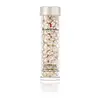What's inside
What's inside
 Key Ingredients
Key Ingredients

 Benefits
Benefits

 Concerns
Concerns

 Ingredients Side-by-side
Ingredients Side-by-side

Water
Skin ConditioningDimethicone
EmollientGlycerin
HumectantMethyl Trimethicone
Skin ConditioningBis-PEG-18 Methyl Ether Dimethyl Silane
EmollientButylene Glycol
HumectantIsopropyl Isostearate
EmollientPPG-15 Stearyl Ether
EmollientPEG-10 Dimethicone
Skin ConditioningYeast Extract
Skin ConditioningTripeptide-32
Skin ConditioningSodium Hyaluronate Crosspolymer
HumectantSodium Hyaluronate
HumectantHydrolyzed Sodium Hyaluronate
Skin ConditioningHydrolyzed Algin
Lactobacillus Ferment
Skin ConditioningAdansonia Digitata Seed Extract
Skin ConditioningSoy Amino Acids
Skin ConditioningAminopropyl Ascorbyl Phosphate
AntioxidantResveratrol
AntioxidantAlgae Extract
EmollientSalicylic Acid
MaskingErgothioneine
AntioxidantTocopheryl Acetate
AntioxidantLactis Proteinum
Skin ConditioningAvena Sativa Kernel Extract
AbrasiveCitrus Medica Vulgaris Fruit Extract
AntioxidantLaminaria Digitata Extract
Skin ProtectingLens Esculenta Fruit Extract
Skin ConditioningPyrus Malus Fruit Extract
Skin ConditioningCaffeine
Skin ConditioningSodium PCA
HumectantPropylene Glycol Caprylate
Skin ConditioningTriticum Vulgare Germ Extract
Skin ConditioningLavandula Angustifolia Oil
MaskingHordeum Vulgare Extract
EmollientAnthemis Nobilis Flower Extract
MaskingIsohexadecane
EmollientPolysilicone-11
Methyldihydrojasmonate
MaskingSodium Lactate
BufferingDisteardimonium Hectorite
StabilisingIsododecane
EmollientPolyacrylate Crosspolymer-6
Emulsion StabilisingSqualane
EmollientPolyethylene
AbrasivePropylene Carbonate
SolventPentylene Glycol
Skin ConditioningDisodium EDTA
BHT
AntioxidantPotassium Sorbate
PreservativeSodium Benzoate
MaskingPhenoxyethanol
PreservativeLinalool
PerfumingCI 14700
Cosmetic ColorantCI 19140
Cosmetic ColorantWater, Dimethicone, Glycerin, Methyl Trimethicone, Bis-PEG-18 Methyl Ether Dimethyl Silane, Butylene Glycol, Isopropyl Isostearate, PPG-15 Stearyl Ether, PEG-10 Dimethicone, Yeast Extract, Tripeptide-32, Sodium Hyaluronate Crosspolymer, Sodium Hyaluronate, Hydrolyzed Sodium Hyaluronate, Hydrolyzed Algin, Lactobacillus Ferment, Adansonia Digitata Seed Extract, Soy Amino Acids, Aminopropyl Ascorbyl Phosphate, Resveratrol, Algae Extract, Salicylic Acid, Ergothioneine, Tocopheryl Acetate, Lactis Proteinum, Avena Sativa Kernel Extract, Citrus Medica Vulgaris Fruit Extract, Laminaria Digitata Extract, Lens Esculenta Fruit Extract, Pyrus Malus Fruit Extract, Caffeine, Sodium PCA, Propylene Glycol Caprylate, Triticum Vulgare Germ Extract, Lavandula Angustifolia Oil, Hordeum Vulgare Extract, Anthemis Nobilis Flower Extract, Isohexadecane, Polysilicone-11, Methyldihydrojasmonate, Sodium Lactate, Disteardimonium Hectorite, Isododecane, Polyacrylate Crosspolymer-6, Squalane, Polyethylene, Propylene Carbonate, Pentylene Glycol, Disodium EDTA, BHT, Potassium Sorbate, Sodium Benzoate, Phenoxyethanol, Linalool, CI 14700, CI 19140
Dimethicone
EmollientCaprylic/Capric Triglyceride
MaskingDimethicone/Vinyltrimethylsiloxysilicate Crosspolymer
Silica
AbrasiveEthylhexyl Palmitate
EmollientC12-15 Alkyl Benzoate
AntimicrobialDimethiconol
EmollientButylene Glycol
HumectantCeramide Ng
Skin ConditioningCeramide NP
Skin ConditioningCeramide Ns
Skin ConditioningCyclopentasiloxane
EmollientDiethylhexyl Syringylidenemalonate
Skin ProtectingEthylhexyl Cocoate
EmollientHelianthus Annuus Seed Oil
EmollientHydrogenated Castor Oil
EmollientHydrolyzed Sodium Hyaluronate
Skin ConditioningLactic Acid
BufferingLecithin
EmollientOlea Europaea Fruit Oil
MaskingPalmitoyl Hexapeptide-12
Skin ConditioningPEG-10 Phytosterol
EmulsifyingPentylene Glycol
Skin ConditioningPersea Gratissima Oil
Skin ConditioningPhytosphingosine
Skin ConditioningPhytosterols
Skin ConditioningPropylene Glycol Dicaprylate/Dicaprate
EmollientRicinus Communis Seed Oil
MaskingSilica Dimethyl Silylate
EmollientSodium Hyaluronate
HumectantTribehenin
EmollientZingiber Zerumbet Extract
Skin ConditioningPhenoxyethanol
PreservativeDimethicone, Caprylic/Capric Triglyceride, Dimethicone/Vinyltrimethylsiloxysilicate Crosspolymer, Silica, Ethylhexyl Palmitate, C12-15 Alkyl Benzoate, Dimethiconol, Butylene Glycol, Ceramide Ng, Ceramide NP, Ceramide Ns, Cyclopentasiloxane, Diethylhexyl Syringylidenemalonate, Ethylhexyl Cocoate, Helianthus Annuus Seed Oil, Hydrogenated Castor Oil, Hydrolyzed Sodium Hyaluronate, Lactic Acid, Lecithin, Olea Europaea Fruit Oil, Palmitoyl Hexapeptide-12, PEG-10 Phytosterol, Pentylene Glycol, Persea Gratissima Oil, Phytosphingosine, Phytosterols, Propylene Glycol Dicaprylate/Dicaprate, Ricinus Communis Seed Oil, Silica Dimethyl Silylate, Sodium Hyaluronate, Tribehenin, Zingiber Zerumbet Extract, Phenoxyethanol
 Reviews
Reviews

Ingredients Explained
These ingredients are found in both products.
Ingredients higher up in an ingredient list are typically present in a larger amount.
Butylene Glycol (or BG) is used within cosmetic products for a few different reasons:
Overall, Butylene Glycol is a safe and well-rounded ingredient that works well with other ingredients.
Though this ingredient works well with most skin types, some people with sensitive skin may experience a reaction such as allergic rashes, closed comedones, or itchiness.
Learn more about Butylene GlycolDimethicone is a type of synthetic silicone created from natural materials such as quartz.
What it does:
Dimethicone comes in different viscosities:
Depending on the viscosity, dimethicone has different properties.
Ingredients lists don't always show which type is used, so we recommend reaching out to the brand if you have questions about the viscosity.
This ingredient is unlikely to cause irritation because it does not get absorbed into skin. However, people with silicone allergies should be careful about using this ingredient.
Note: Dimethicone may contribute to pilling. This is because it is not oil or water soluble, so pilling may occur when layered with products. When mixed with heavy oils in a formula, the outcome is also quite greasy.
Learn more about DimethiconeThis ingredient is created by putting sodium hyaluronate through hydrolysis.
You might know this as 'mini' or 'ultra low-molecular weight' hyaluronic acid. The small molecule size means it is able to travel deeper in the skin.
According to studies, low molecular-weight hyaluronic acid can:
One study from 2011 found ultra-low weight HA to show pro-inflammatory properties. Another study from 2022 found it to downregulate UV-B induced inflammation.
Hydrolysis is a process of changing a molecule using water or enzymes.
This ingredient is water-soluble.
Learn more about Hydrolyzed Sodium HyaluronatePentylene glycol is typically used within a product to thicken it. It also adds a smooth, soft, and moisturizing feel to the product. It is naturally found in plants such as sugar beets.
The hydrophilic trait of Pentylene Glycol makes it a humectant. As a humectant, Pentylene Glycol helps draw moisture from the air to your skin. This can help keep your skin hydrated.
This property also makes Pentylene Glycol a great texture enhancer. It can also help thicken or stabilize a product.
Pentylene Glycol also acts as a mild preservative and helps to keep a product microbe-free.
Some people may experience mild eye and skin irritation from Pentylene Glycol. We always recommend speaking with a professional about using this ingredient in your routine.
Pentylene Glycol has a low molecular weight and is part of the 1,2-glycol family.
Learn more about Pentylene GlycolPhenoxyethanol is a preservative that has germicide, antimicrobial, and aromatic properties. Studies show that phenoxyethanol can prevent microbial growth. By itself, it has a scent that is similar to that of a rose.
It's often used in formulations along with Caprylyl Glycol to preserve the shelf life of products.
Sodium Hyaluronate is hyaluronic acid's salt form. It is commonly derived from the sodium salt of hyaluronic acid.
Like hyaluronic acid, it is great at holding water and acts as a humectant. This makes it a great skin hydrating ingredient.
Sodium Hyaluronate is naturally occurring in our bodies and is mostly found in eye fluid and joints.
These are some other common types of Hyaluronic Acid:
Learn more about Sodium Hyaluronate